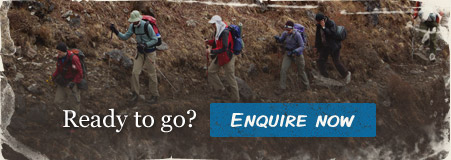Langtang & Helambu Treks
(1) Langtang
Discover the heavenly beauty of the land with its rushing rivers and lush forests. Langtang National Park shows impressive landscapes, with more than 1000 plants, birds exceeding 150 species and numerous other mammals. Designated a national park in 1976, the Langtang valley is the second largest national park of Nepal. It is one of the least crowded trekking destinations. A trek to this isolated region offers an opportunity to explore ancient villages, a wide range of animals (wild dog, red pandas, pika, muntjac, musk deer, Himalayan black bear, Himalayan tahr, ghoral, serow, rhesus monkey and common langur). Culturally it is rich in many artful monasteries. One can climb famous peaks and visit glittering ice lakes or glorious glaciers at comfortable, relatively low elevations.(2) Gosainkund & Helambu
Gosainkund is one of the Hindu holy places and is considered to be created by Lord Shiva. The Buddhist Tamangs (tribes) that live nearby also revere it as their holy place. Every August, on a full-moon night, the lake is thronged with pilgrims for a big festival. On other days, the lake sits in a tranquil atmosphere welcoming nature lovers.In this course, you start from Dhuche, which is also the starting point of the Langtang Valley, and head for Gosainkund, the source of the Trisuli Khola. The course continues and goes over the highest point Laurebina Pass (4,610m) and follows the scenic ridge to the Helambu region and then onto the Kathmandu Valley.
(3) Ganesh Himal
From Trisuli Bazaar to Chumta DandaThe Ganesh Himal is situated 70km north-north-east of Kathmandu. Its beautiful mountains can even be seen from the Kathmandu Valley. Though it is within easy access from Kathmandu, very few trekkers visit there. It is one of the precious areas where the simple life of the Himalayas can still be observed.
This course starts from Trisuli Bazaar in the semitropical sun, goes up to a fairly high elevation, where a close view of Ganesh II (7,163m) and Ganesh IV (7,052m) can be enjoyed, and descends to Syabrubensi after crossing over two passes. This is a course without lodges for trekkers. You are advised to be thoroughly prepared before departure. The highest elevation is more than 4,000m, requiring caution for altitude sickness.
For further information and prices for any of the above treks please contact us.

Featured Treks in Nepal
- Annapurna Base Camp
- Annapurna Circuit Trek
- Annapurna Journey
- Annapurna Views - Royal/Skyline Trek
- Arun Valley Trek
- Classic Everest Trek
- Everest & East Nepal Treks
- Everest - Instant Everest Trek
- Everest Base Camp & Kala Pattar via Gokyo
- Everest Panorama Trek
- Ganesh Himal
- Ghandrung Trek
- Ghorepani Poon Hill Trek
- Gokyo Trek
- Gorkha to Pokhara
- Helambu Culture Trek
- High in Dhaulagiri
- Khaptad & Ramaroshan
- Langtang & Helambu Treks
- Langtang Valley & Gossainkund pass
- Langtang Valley Crossing Ganja-La Pass
- Langtang Valley Trek
- Lower Dolpo Region
- Majestic Kanchenjunga
- Makalu-Barun Valley Trek
- Mountain Biking, Pilgrimages, etc.
- Panch Pokhari Trek
- Panchase & the Annapurnas
- Rafting Nepal
- Rara Lake Trek
- Rolwaling Valley Camping Trek
- Safari Treks
- Siklis Village Trek







